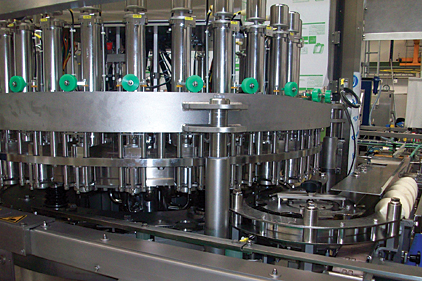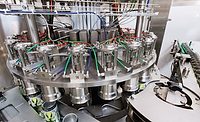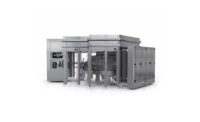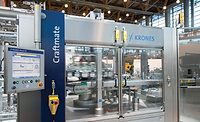As the beverage industry continues to see increases in packaging shapes and sizes as well as sustainable offerings, it’s clear that beverage-makers aren’t lagging in the innovation department. However, this means that equipment manufacturers are tasked with ensuring that the equipment they produce meets these new material needs.
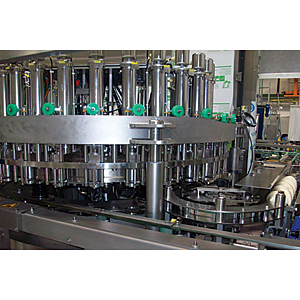
|
| To help meet craft brewing trends, Krones USA offers chamber filling valve and flow meter filling valve machines. |
Since the 1970s, can manufacturers have reduced the weight of aluminum cans by approximately 35 percent, according to the Can Manufacturers Institute’s (CMI) website. For example, a beverage can was roughly 0.7 ounces in 1973 versus 0.463 ounces in 2011, based on CMI and Aluminum Association data from a recent “Aluminum Beverage Can Life Cycle Analysis” survey. Lightweighting cans presents challenges when also taking speed into consideration, experts note.
“Aluminum beverage can materials continue to get lighter, and this makes high-speed seaming increasingly difficult,” says Mike Mangone, vice president of sales with Havre de Grace, Md.-based ShoreLine Packaging and Processing Machinery, the U.S. representative of Swiss-based Ferrum’s full range of can seamers. “It is a big challenge for the manufacturers to design new machines that will handle these cans properly without damaging them.”
Crafting opportunities
As sustainability practices affect packaging, consumer trends also are changing the can landscape. In an interview for Beverage Industry’s December 2012 article about the craft beer segment, Chicago-based SymphonyIRI Group’s Senior Vice President of Beverage Alcohol Client Insights Dan Wandel noted that sales of craft beer in cans in supermarkets accounted for roughly 3 percent of the market share during the 52 weeks ending Oct. 7, 2012. Although notably smaller compared with glass at 97 percent, Wandel added that cans accounted for only 1.5 percent in the supermarket channel in the previous year.
“Consumers want to take their beer everywhere they go,” says Barry Fenske, product manager of the filling division for Krones USA, Franklin, Wis. “Cans are allowed in places that glass is not. Craft brewers are jumping all over this. This is a segment that is really heating up.”
To help meet these craft brewing trends, Krones offers chamber filling valve and flow meter filling valve machines.
The Volumetic VOC filler supplies the required amount of product for each filling valve in a precision-made metering chamber, the company says. Krones ensures exactness in dosing by using a high-resolution transsonar probe that is regulated by the magnetic float, it adds. The probe switching points are set so that the volume of the removed beverage will empty the metering chamber down to the preset level while the filling valve is continually flushed with product, Krones explains.
The centering unit for the filler is controlled by a cam roller that is raised as cans enter the machine, which are then placed under the filling valve, it adds.
The Volumetic VODM-C differs from the VOC filler in that it correctly fills the quantity needed by use of an inductive flow meter, Krones says. An inductive flow meter is in each product feed pipe upstream on the filling valve that measures the electrical conductivity, it adds. This measurement determines the amount of liquid flowing within the pipes.
Depending on the type of product, the chamber or flow meter filling valve systems can fill 10,000 to 130,000 cans an hour, according to Krones.
Given the vast number of SKUs some craft brewers might need to accommodate, Fenske notes that the old way of mechanically filling cans is giving way to electro-pneumatic means, which allow many SKUs to run on one machine and to be optimized for each SKU’s needed speed.
“For the craft beer guys, can filling is a serious trend,” Fenske says. “With the many SKUs they tend to run, Krones’ electro-pneumatic filling valves answer that call and give them the most that the machine can offer speed-wise.”
In addition to handling the differing SKUs, Krones’ filling systems also feature changeover for different can rims. For example, the combined centring bell can be used for 200 and 202 can lid types. It also features quick-change Raptec guidance handling parts, the company says.
KHS USA Inc., Waukesha, Wis., also offers a volumetric filling system with its Innofill Can DVD, a computer-controlled can filler. With speeds of 120,000 cans an hour, the filling machine is driven by a homocinetic joint shaft from the main drive of the can seamer. High filling accuracy is ensured by measuring filling volumes with electromagnetic inductive flow meters, the company says.
The Innofill Can DVD also is designed for optimal cleaning. The filler machine can be optionally equipped with cleaning devices for external cleanup. Internal clean-in-place containers also are attached to the filling valves, it says.
Efficient operations
Continuing to affect can filling operations is the range of sizes and shapes of containers.
“Over recent years, can-makers have dramatically increased their variety of can sizes and shapes, primarily to accommodate the demand of beverage companies wanting to differentiate their products and packages,” says Maura Marcks, marketing coordinator for CMC-Kuhnke, Albany, N.Y. “Additional factors have also contributed such adherence to new regulations in air travel and school meal programs.”
Marcks adds that the number of different beverage cans often provides a challenge for filling and handling operations.
“Further efforts toward package differentiation have seen even more additions to the metal packaging line,” she says. “Other new products like the aluminum bottle, the releasable bottle can and the resealable beverage end are becoming popular among brand owners for their marketing value.”
Offering adaptability to different sizes and shapes, CMC-Kuhnke’s MARS-XTS is a fully automated and non-destructive system.
“CMC-Kuhnke’s MARS-XTS represents a monumental shift in how the canning industry will perform seam inspections in the future,” Marcks says. “We believe automated, non-destructive testing will become the standard method for double seam inspections within the next 10-15 years.”
Controlling costs
Although differentiation within packaging can help in the marketing of consumer packaged goods, rising costs can be a concern.
The cost of aluminum has increased roughly 50 percent since 2001, CMC-Kuhnke’s Marcks says.
“Continuing increases in labor costs have caused brand owners to look at new ways of saving money and resources as the cost of their package rises,” she adds.
Noting the financial benefits, ShoreLine’s Mangone says that a reduction in the number of machines also can provide beneficial synergies within operations.
“Machines should be created that not only share internal components within a ‘family’ but also that the machines be capable of running food as well as beverages on the same model, without having to make any significant modifications,” he says. “The major manufacturers such as Ferrum and Scale Angelus already have a family line of machines they are working [on] to further refine the concept. Effective reduction [of] the number and type of seamers means the manufacturer can reduce the number of spare parts they are required to produce, which equates to reduced cost for the customers.”
Customers also want to have reliable equipment that is affordable to operate, Mangone explains.
“Ferrum can seamers historically offer very good [total cost of ownership] numbers as compared to other machines,” he says. “Rebuilt machines using high-quality aftermarket parts is another way to be cost efficient.”
Availability of spare parts at a reasonable cost from aftermarket part suppliers, such as Norwood, Ma.-based American Holt, that offer a range of high-quality replacement seamer parts can provide savings for original equipment manufacturers, Mangone says.
“Customers want the manufacturer or manufacturer service base to bear a larger responsibility for stocking replacement parts as well as reduced lead time to get emergency parts,” he explains. “[M]anufacturers such as Ferrum, KHS, Krones, etc., have parts and service bases in the U.S., and in the case of Ferrum, there is a service engineer that now resides in the U.S. in order to provide a factory-trained technician for the [North American] market. The new Ferrum service base, in addition to parts, will be able to provide training for the customer’s technicians.”
But even with efficient, cost-effective operations, also front of mind for beverage-makers is an emphasis on machine sanitation.
Mangone notes that Ferrum offers design features such as rounded corners and edges on machine surfaces and can transfer tables in order to reduce or eliminate areas where germs can accumulate. BI
